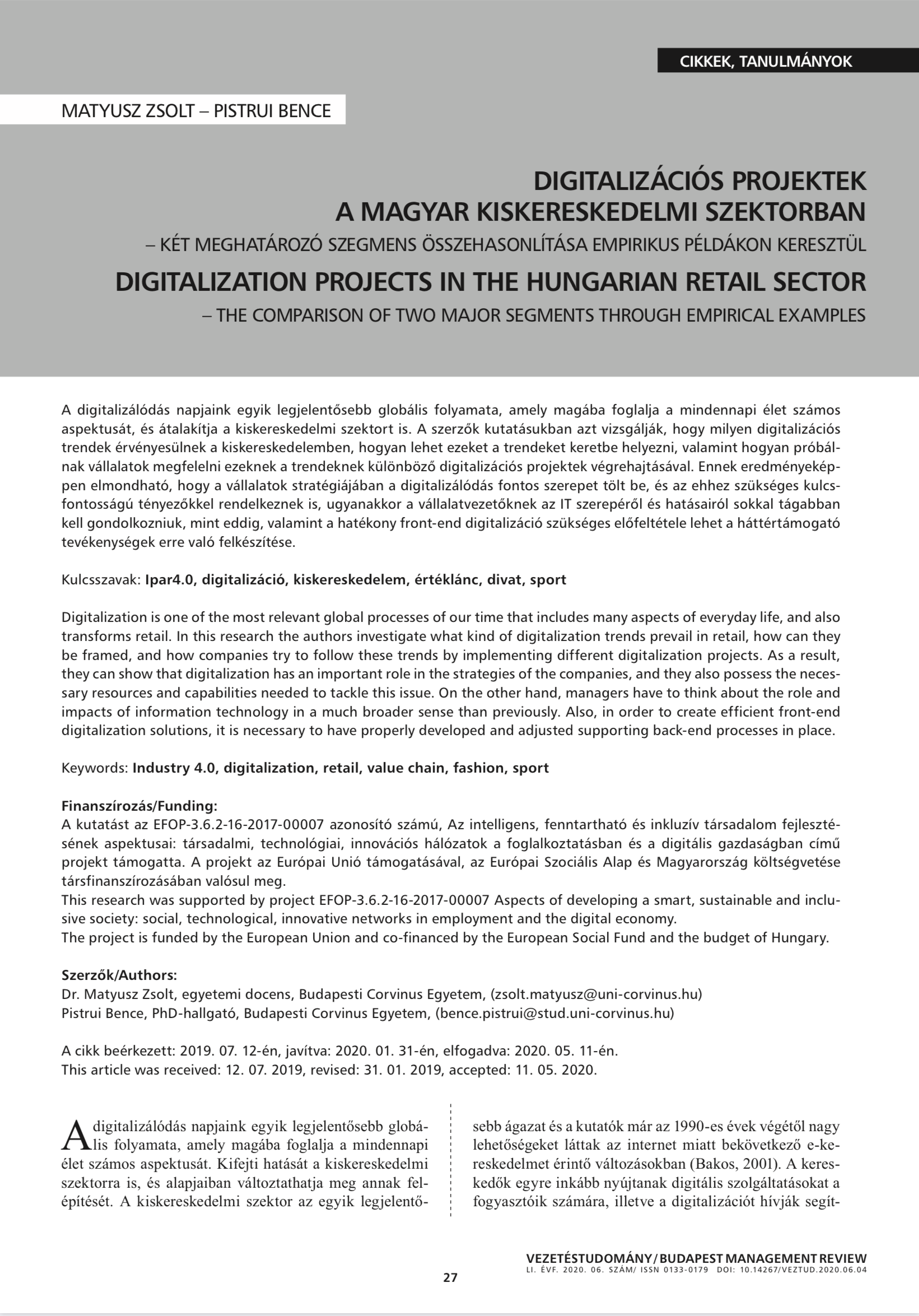Digitalizációs projektek a magyar kiskereskedelmi szektorban
Két meghatározó szegmens összehasonlítása empirikus példákon keresztül
DOI:
https://doi.org/10.14267/VEZTUD.2020.06.04Kulcsszavak:
Ipar 4.0, digitalizáció, kiskereskedelem, értéklánc, divat, sportAbsztrakt
A digitalizálódás napjaink egyik legjelentősebb globális folyamata, amely magába foglalja a mindennapi élet számos aspektusát, és átalakítja a kiskereskedelmi szektort is. A szerzők kutatásukban azt vizsgálják, hogy milyen digitalizációs trendek érvényesülnek a kiskereskedelemben, hogyan lehet ezeket a trendeket keretbe helyezni, valamint hogyan próbálnak vállalatok megfelelni ezeknek a trendeknek különböző digitalizációs projektek végrehajtásával. Ennek eredményeképpen elmondható, hogy a vállalatok stratégiájában a digitalizálódás fontos szerepet tölt be, és az ehhez szükséges kulcsfontosságú tényezőkkel rendelkeznek is, ugyanakkor a vállalatvezetőknek az IT szerepéről és hatásairól sokkal tágabban kell gondolkozniuk, mint eddig, valamint a hatékony front-end digitalizáció szükséges előfeltétele lehet a háttértámogató tevékenységek erre való felkészítése.
Letöltések
Hivatkozások
Agárdi, I. (2018). A digitalizáció mint a kiskereskedelmi tevékenységet integráló tényező. Vezetéstudomány, 49(12), 50–57. https://doi.org/10.14267/veztud.2018.12.06
Bagdasarov, Z., Martin, A. A., & Buckley, M. R. (2020). Working with robots: Organizational considerations. Organizational Dynamics. https://doi.org/10.1016/j.orgdyn.2018.09.002
Bakos, Y. (2001). The Emerging Landscape for Retail E-Commerce. Journal of Economic Perspectives, 15(1), 69–80. https://pubs.aeaweb.org/doi/pdf/10.1257/jep.15.1.69
Bertacchini, F., Bilotta, E., & Pantano, P. (2017). Shopping with a robotic companion. Computers in Human Behavior, 77, 382-395. https://doi.org/10.1016/j.chb.2017.02.064
Bhave, A., Biggs, C., Burggraaff, P., Loftus, B., & Pathak, S. (2018): Accelerating Digital Innovation in Retail. The Boston Consulting Group. http://image-src.bcg.com/Images/BCG-Accelerating-Digital-Innovationin-Retail-June-2018_tcm21-194430.pdf
Bucsky, P. (2019). Megnyitották a magyar pénztárcákat a nemzetközi divatmárkák. https://g7.hu/vallalat/20190422/megnyitottak-a-magyarpenztarcakat-a-nemzetkozi-divatmarkak/
Deloitte (2017). Disruptions in Retail through Digital Transformation. Deloitte Touche Tohmatsu India LLP. https://www2.deloitte.com/content/dam/Deloitte/in/Documents/CIP/in-cip-disruptions-in-retail-noexp.pdf
DKFS (2017). Digitális kereskedelemfejlesztési stratégia. https://www.kormany.hu/download/c/88/f0000/Strat%C3%A9gia.pdf Letöltés dátuma: 2020.05.04.
Donnelly, C., & Wright, O. (2017). Painting Digital Future of Retail and Consumer. Accenture Strategy, 1–13.https://www.accenture.com/_acnmedia/PDF-52/Accenture-Strategy-DD-Painting-Digital-Future-POV-v2.pdf
Frey, C. B., & Osborne, M. A. (2017). The future of employment: How susceptible are jobs to computerisation? Technological Forecasting and Social Change, 114, 254-280. https://doi.org/10.1016/j.techfore.2016.08.019
Fuentes, C., Bäckström, K., & Svingstedt, A. (2017). Smartphones and the reconfiguration of retailscapes: Stores, shopping, and digitalization. Journal of Retailing and Consumer Services, 39, 270–278. https://doi.org/10.1016/j.jretconser.2017.08.006
Gartner Glossary (2020a). „Digitization”. https://www.gartner.com/en/information-technology/glossary/digitization
Gartner Glossary (2020b). „Digitalization”. https://www.gartner.com/en/information-technology/glossary/digitalization
GKI Digital (2020). Bruttó 625 milliárd forintért vásároltunk tavaly a hazai webáruházakból. https://gkidigital.hu/2020/03/11/brutto-625-milliard-forintert-vasaroltunk-tavaly-a-hazaiwebaruhazakbol/
Grewal, D., Ailawadi, K. L., Gauri, D., Hall, K., Kopalle, P., & Robertson, J. R. (2011). Innovations in retail pricing and promotions. Journal of Retailing, 87, S43–S52. https://doi.org/10.1016/j.jretai.2011.04.008
Hagberg, J., Sundstrom, M., & Egels-Zandén, N. (2016). The digitalization of retailing: an exploratory framework. International Journal of Retail & Distribution Management, 44(7), 694–712. https://doi.org/10.1108/IJRDM-09-2015-0140
Hagberg, J., Jonsson, A., & Egels-Zandén, N. (2017). Retail digitalization: Implications for physical stores. Journal of Retailing and Consumer Services, 39, 264–269. https://doi.org/10.1016/j.jretconser.2017.08.005
Hänninen, M., Smedlund, A., & Mitronen, L. (2018). Digitalization in retailing: multi-sided platforms as drivers of industry transformation. Baltic Journal of Management, 13(2), 152–168. https://doi.org/10.1108/BJM-04-2017-0109
Investopedia (2019). The World’s Top 10 Retailers. https://www.investopedia.com/articles/markets/122415/worlds-top-10-retailers-wmt-cost.asp
Keeling, K., Keeling, D., & McGoldrick, P. (2013). Retail relationships in a digital age. Journal of Business Research, 66(7), 847–855. https://doi.org/10.1016/j.jbusres.2011.06.010
KSH (2019a). Gyorstájékoztató. Kiskereskedelem, 2018. december, 2018. év (második becslés). http://www.ksh.hu/docs/hun/xftp/gyor/kis/kis1812.html
KSH (2019b). Digitális gazdaság és társadalom, 2018. http://www.ksh.hu/docs/hun/xftp/idoszaki/ikt/ikt18.pdf
KSH (2019c). A kiskereskedelmi üzletek forgalma üzlettípusonként. http://www.ksh.hu/docs/hun/xstadat/xstadat_eves/i_okfa007b.html
KSH (2019d). A kiskereskedelmi üzletek forgalma üzlettípusonként (2000–). http://www.ksh.hu/docs/hun/xstadat/xstadat_eves/i_okfa007b.html
KSH (2019e). A kiskereskedelmi eladási forgalom főbb árucsoportonként (korábbi módszertan alapján előállított adatok). https://www.ksh.hu/docs/hun/xstadat/xstadat_evkozi/e_okfb002c.html
Kumar, S. (2016). Transforming the Future of Retail with Robotics-As-A-Service (Abstract). May, 1–6. https://www.tcs.com/content/dam/tcs/pdf/Industries/Retaillogistics/Abstract/Transforming-the-Future-of-Retailwith-Robotics-As-A-Service.pdf
Lehdonvirta, V. (2012). A history of the digitalization of consumer culture: From Amazon through Pirate Bay to Farmville. In J. Denegriknot & M. Molesworth, (Eds.), Digital Virtual Consumption (pp. 11-29). London: Routledge.
Lu, L., Cai, R., & Gursoy, D. (2019). Developing and validating a service robot integration willingness scale. International Journal of Hospitality Management, 80, 36-51. https://doi.org/10.1016/j.ijhm.2019.01.005
Mäenpää, R., & Korhonen, J. J. (2015). Digitalization in retail: the impact on competition. In Collin, J., Hiekkannen, K., Korhonen, J.J, Halen, M., Itälä, T., & Helenius, M. (Eds.), IT Leadership in Transition. The Impact of Digitalization on Finnish Organizations (pp. 89-102). Helsinki: Aalto University.
Makridakis, S. (2017). The forthcoming Artificial Intelligence (AI) revolution: Its impact on society and firms. Futures, 90, 46-60. https://doi.org/10.1016/j.futures.2017.03.006
Merriam-Webster (2020). „Digitalization”. https://www.merriam-webster.com/dictionary/digitalization
Pantano, E., & Vannucci, V. (2019). Who is innovating? An exploratory research of digital technologies diffusion in retail industry. Journal of Retailing and Consumer Services, 49, 297-304. https://doi.org/10.1016/j.jretconser.2019.01.019
Porter, M. E. (1985). Competitive Advantage. New York, USA: The Free Press.
Priporas, C. V., Stylos, N., & Fotiadis, A. K. (2017). Generation Z consumers’ expectations of interactions in smart retailing: A future agenda. Computers in Human Behavior, 77, 374-381. https://doi.org/10.1016/j.chb.2017.01.058
PwC (2016a). Opportunities and challenges for consumer product and retail companies. PwC. https://www.strategyand.pwc.com/media/file/Industry-4-0-RC.pdf
PwC (2016b). What if the store had a voice? PwC Digital Services. https://digital.pwc.com/content/dam/pwcdigital/US/FeaturedVideos/Abstracts/VID_RET_Abstract.pdf
Strange, R., & Zucchella, A. (2017). Industry 4.0, global value chains and international business. Multinational Business Review, 25(3), 174-184. https://doi.org/10.1108/MBR-05-2017-0028
Shankar, V. (2018). How Artificial Intelligence (AI) is Reshaping Retailing. Journal of Retailing, 94(4), vi–xi. https://doi.org/10.1016/S0022-4359(18)30076-9
Soutjis, B., Cochoy, F., & Hagberg, J. (2017). An ethnography of Electronic Shelf Labels: The resisted digitalization of prices in contemporary supermarkets. Journal of Retailing and Consumer Services, 39, 296–304. https://doi.org/10.1016/j.jretconser.2017.08.009
Statista (2019a). Number of retail chains in Hungary in 2018, by sector. https://www.statista.com/statistics/642255/retail-chains-number-by-sector-hungary/
Statista (2019b). Sports & Outdoor Hungary. https://www.statista.com/outlook/259/139/sports-outdoor/hungary?currency=eur#market-revenue
Verhoef, P. C., Kannan, P. K., & Inman, J. J. (2015). From Multi-Channel Retailing to Omni-Channel Retailing. Introduction to the Special Issue on Multi-Channel Retailing. Journal of Retailing, 91(2), 174–181. https://doi.org/10.1016/j.jretai.2015.02.005
Willems, K., Smolders, A., Brengman, M., Luyten, K., & Schöning, J. (2017). The path-to-purchase is paved with digital opportunities: An inventory of shopper-oriented retail technologies. Technological Forecasting and Social Change, 124, 228–242. https://doi.org/10.1016/j.techfore.2016.10.066

Downloads
Megjelent
Hogyan kell idézni
Folyóirat szám
Rovat
License
Authors assign copyright to Vezetéstudomány / Budapest Management Review. Authors are responsible for permission to reproduce copyright material from other sources.

